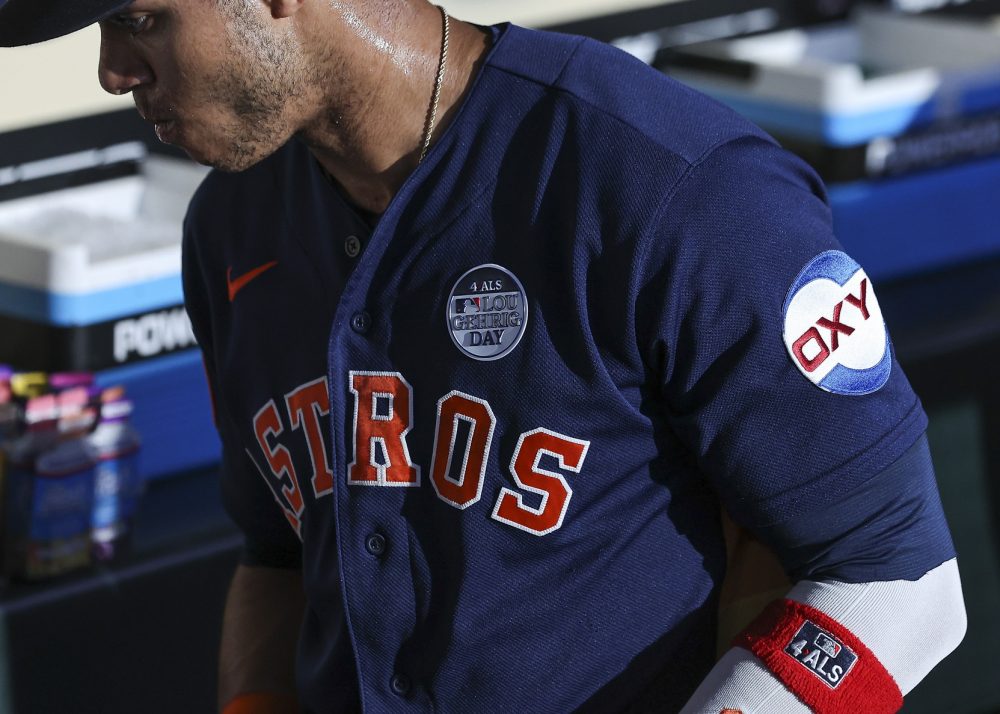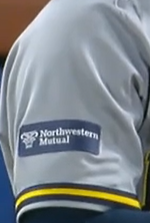
This article was originally published October 25, 2023.
The Collective Bargaining Agreement signed between MLB and the Players’ Association in March of 2022 ushered in several changes, like three wild cards and expanded interleague play. One of the smaller changes was the introduction, for the first time, of advertising patches on player uniforms in 2023. The reason is obvious. Owners’ representative Rob Manfred stated, “That’s a revenue source that is significant enough that it is really impossible for the sport to ignore over the long haul. I think that’s the truth.” (Editor’s note: It’s always convincing, after a statement, to add the sentence “I think that’s the truth.”)
That’s silly, of course. MLB could absolutely choose to ignore advertising on uniforms for as long as it wanted. The NFL has somehow resisted it so far. You’ve probably seen the images of members of Congress wearing NASCAR-style jackets covered with the logos of their contributors, but they still wear suits. But the key in Manfred’s statement is the two words, revenue source. MLB isn’t going to turn away a way to bring in dollars.
Except, in the inaugural season of advertising patches, almost half of teams did. There wasn’t a single division in which every team’s uniforms bore promos for corporate sponsors. In this article, I’ll examine the advertising decisions of all 30 teams, then provide a summary.
I mean, this is the World Series analysis you came here for, right?
National League West
Arizona Diamondbacks: Avnet.

Avnet’s website states: “We’ve adapted to wave after wave of technological change to provide the engineering and supply chain expertise that our customers need to accelerate, scale and extend the lifecycle of their designs.” So that’s why you’ve never heard of the Phoenix-based company. (Editor’s note: It’s less clear why they need you to know about them now.) They sell electronic components to businesses, not consumers. It’s a big company, with 15,800 employees and revenues of over $26.5 billion in the year ended June 30.
Colorado Rockies:
None.
Los Angeles Dodgers:
None.
San Diego Padres: Motorola.
The Padres were the first team to announce an advertising deal. Their patch is the only one that contains only a symbol, no letters. But you recognize that logo, right? (Or maybe you’re too young to have ever owned a flip phone.)
A lot of the ad patches—Arizona’s, for example—feature local companies. Motorola’s based in Chicago. But it has an international footprint. That sort of deal isn’t unknown in sports. Just up the road, the Lakers are in the third year of a five-year deal to display advertising patches for Bibigo, a South Korean food company.
San Francisco Giants: Cruise.

There could not be a more Bay Area deal than the Giants displaying advertising for a driverless ride-hailing service. Cruise is, naturally, headquartered in San Francisco. It is also, arguably less naturally, owned by General Motors. (Editor’s note: Cruise is no longer legally allowed to operate in the city of San Francisco.) (Author’s addendum: And that’s on top of Cruise losing $1.9 billion for GM over the first nine months of the year.)
American League West
Houston Astros: Occidental Petroleum.

If autonomous cars are an automatic fit for the Giants, fossil fuel is an automatic fit for Houston. Occidental Petroleum is headquartered in Houston and is one of the largest hydrocarbon exploration and production (E&P) companies in the world, with 2022 revenues of $36.6 billion and about 12,000 employees worldwide. Since it’s an E&P company, though, you can’t fill up your car with Oxy (it’s both the company’s nickname and its New York Stock Exchange ticker symbol) unleaded. The company gets the stuff out of the ground and sells it to the companies that fuel your car and heat your home.
Los Angeles Angels: Foundation Building Materials.

I know the screenshot here isn’t as clear as it could be, but trust me: There is no way you could read the full company name running along the bottom of the patch unless you were standing next to an Angels player. Bad design, FBM.
Orange County-based FBM distributes drywall, steel framing, acoustic ceilings, and supplies to the construction industry through over 300 locations in the US and Canada. Like Avnet and Oxy, it sells to businesses, not consumers. Founded in 2011, it was taken private in 2021 by American Securities, a New York private equity firm, for $1.4 billion.
Oakland Athletics:
None.
Seattle Mariners:
None.
Texas Rangers:
None.
National League Central
Chicago Cubs:
None.
Cincinnati Reds: Kroger.

There’s a good chance you don’t know most of the uniform sponsors listed so far. I’ll bet you know Kroger, though. After Walmart, it’s the largest grocery store chain in the country. And it’s based in Cincinnati! By revenue, it’s the 24th-largest publicly-traded company in the country, with 2022 revenues of $148 billion and 430,000 employees.
Milwaukee: Northwestern Mutual.

Northwestern Mutual is a financial services company based in Milwaukee, known primarily for its life insurance. Unlike most companies of its ilk, it’s a mutual organization, which means its policyholders receive annual dividends derived from the company’s profits each year.
Pittsburgh Pirates:
None.
St. Louis Cardinals: Stifel Financial.

Stifel is an international financial services firm based in St. Louis, providing wealth management, research, and investment banking services for individuals and institutions. Full disclosure, my last full-time employer was Stifel, for their institutional equities business based in Baltimore. I enjoyed working there. I am not a big Cardinals fan, though.
American League Central
Chicago White Sox:
None.
Cleveland Guardians: Marathon Oil.

Like Occidental Petroleum, Marathon is an oil and gas exploration and production company. Also like Oxy, it’s headquartered in Houston, but it was founded in Lima, Ohio and more recently was based in Findlay, Ohio. Neither Lima nor Findlay is anywhere near Cleveland, in case you were wondering.
Marathon also operates over 6,000 gas stations, mostly in Ohio and Indiana. This has nothing to do with anything, but if you ever decide to drive on I-90 from New York to Minnesota (don’t), you want to fill up in Ohio. Huge gas stations, relatively low gas taxes. Taxes are lower in Wisconsin but there aren’t as many stations, so prices aren’t necessarily lower.
Detroit Tigers: Meijer.

Meijer, headquartered in the Grand Rapids area, is sort of the Walmart of the Mideast*, with almost half of its 265 stores in Michigan and others in Ohio, Indiana, Illinois, Wisconsin, and Kentucky. In 1962, it opened a combined grocery and department store under one roof, the first “supercenter” in the country.
*Yes, there’s such a thing as the Mideast. I’m from Minnesota. That’s the Midwest. If you’re in the Eastern time zone, you’re in the Mideast.
Kansas City Royals:
None.
Minnesota Twins:
None.
National League East
Atlanta Braves: QUIKRETE Companies.

QUIKRETE was founded in 1940 in Atlanta. The privately-held company is the largest manufacturer of pre-blended concrete and cement products in the U.S. If you go to the local hardware store, there’s a good chance you’ll see QUIKRETE’s product in bags the same color as the shoulder patch. The company sells a number of other building products but its lead products carry the company name.
Miami Marlins: ADT.

I don’t know, maybe it’s just me, but I think it’s hilarious that the Marlins are sponsored by the largest security company in the country. Headquartered about 45 miles north of Miami in Boca Raton, it pulled in $6.4 billion in revenues last year from over 6 million customers. “Hey, we made it to the playoffs but we’re missing our two best starting pitchers. Call ADT!” “We’re missing the general manager who took us to our first playoff appearance* in 20 years. Call ADT!”
*2020 does not count.
New York Mets: New York-Presbyterian Hospital.

The US, as you probably know, has the most expensive healthcare system in the world. There are a number of reasons for this. One of those many factors is monopolies. In several communities, mostly smaller ones, there might be only one entity owning the only hospital or hospitals, the only advanced imaging provider, the only cardiology group, etc., so they can charge whatever they want to private insurers. This is not a problem in New York City. By revenues, New York-Presbyterian is the largest, with $6.9 billion in net patient revenues, but there are 18 others with over $1 billion in revenues. (There are only three such hospitals in Miami, for example.) Lots of competition! The Mets tied the Marlins for 14th in games missed due to injuries this season. The shoulder patches probably didn’t have any impact.
Philadelphia Phillies:
None.
Washington Nationals:
None.
American League East
Baltimore Orioles:
None.
Boston Red Sox: MassMutual.

The patch is as small as it looks in the photo; it may be the smallest in MLB. MassMutual is headquartered in Springfield, which is on the other side of the state from Boston, but you know, it’s New England, nothing’s really very far away from anything else as the crow flies. Like Milwaukee’s sponsor, Northwestern Mutual, it’s a privately-held mutual insurance company. Its 2022 revenues were $10.7 billion compared to $34.9 million for Northwestern Mutual. They’re both really big insurance companies.
New York Yankees: Starr Insurance.

It seems incongruous that Boston and New York, the teams that won’t put players’ names on the back of their uniforms (and especially the no-beard Yankees) would be willing to put advertising on their players’ shoulders. Oh well, as a late friend of mine would say, it rhymes with honey and it’s sweet. Starr is an insurance company, but unlike Milwaukee’s Northwestern Mutual and Boston’s MassMutual, whose bread and butter is selling life insurance to individuals, Starr’s business is primarily property and casualty insurance for commercial accounts. It’s based in New York though it was established in 1919 in Shanghai.
Tampa Bay Rays:
None.
Toronto Blue Jays: Toronto-Dominion Bank.

Like Motorola and Occidental Petroleum, Toronto-Dominion doesn’t bother with its full name, but it doesn’t have to. It’s known as TD Bank Group in Canada. Unlike in the US, where there are big multinational banks but also regional and local banks, the banking sector in Canada is dominated by just a few national banks, known as The Big Five. The two largest, easily, are Royal Bank of Canada and TD. It has an international footprint and had 2022 revenues of nearly $46 billion. It is, of course, headquartered in Toronto.
***
What does it all mean? I’m a finance guy, not a marketing guy, and I’ll be honest, there are aspects of this I don’t understand. I get that consumer companies would be willing to pay to get their name in front of potential customers. I’m less clear why business-to-business companies (Arizona’s Avnet, Houston’s Occidental Petroleum, the Angels’ Foundation Building Materials, the Yankees’ Starr Insurance) think it makes sense to advertise on baseball uniforms. Do they think purchasing managers for potential customers are baseball fans? But then, I don’t understand why drug companies advertise remedies for diseases I’ve never heard of, either, so what do I know?
I also find it odd that the teams I’d think would be most desperate for advertising revenues don’t have patches, while some of the most deep-pocketed teams do. I could easily envision a team like the Nationals not coming to a deal because they were holding out for more money, but what’s up with the Pirates? The Royals? It makes sense that a company concerned about damaging their brand might not want advertising on Oakland’s uniforms, but the Twins? The Rays?
I was thinking of ranking the patches, but aesthetics aren’t my thing. I think you can tell which patches I find the most puzzling. More importantly, until I did the research for this article, I never really noticed many of them. I don’t think that’s what the advertisers had in mind.
Thank you for reading
This is a free article. If you enjoyed it, consider subscribing to Baseball Prospectus. Subscriptions support ongoing public baseball research and analysis in an increasingly proprietary environment.
Subscribe now